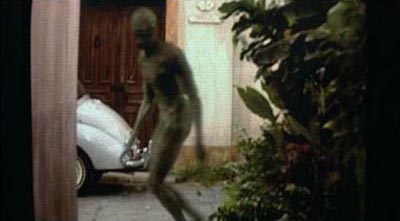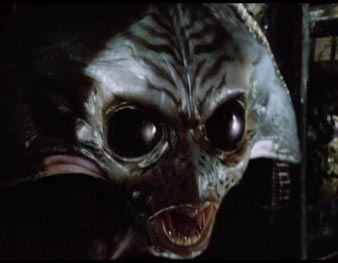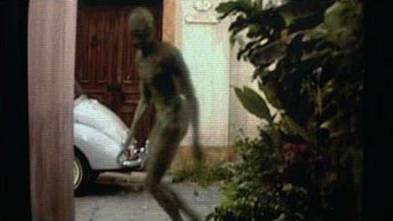What aliens would really be like
Source: ca.news.yahoo.com

If we ever make contact with aliens, they might be more interested in learning about Van Gogh and Bach than Einstein or Newton, scientists said Saturday.
Art may attract aliens more than academics because any extraterrestrial civilization that we are able to get in touch with is likely to be much older than us and more technically advanced, researchers said here at the SETIcon conference on the search for extraterrestrial intelligence.
Humans would probably have little to teach them about science and mathematics that they don’t already know, the theory suggests. However, our art and music is singularly human, and could likely be fascinating to an alien species.
"What would the other guys want to know about us? What in the world do we have to offer?" asked Douglas Vakoch, director of interstellar message composition at the SETI (Search for Extraterrestrial Intelligence) Institute in Mountain View, Calif. "If they’re so advanced, we probably can’t teach them about science, but we can tell them what it’s like to be at this precarious point where we don’t know if we’re going to continue as a species."
Advanced alien civilizations will probably have overcome the issues that threaten adolescent species like our own, such as how to live sustainably without degrading the planet, and how not to destroy ourselves with biological or technical warfare, Vakoch said. Advanced extraterrestrials might even have forgotten what it’s like to live as we do, with the future in question. And the best way to teach them about what it’s like to be human may be through art and music, Vakoch added.
However, aliens are likely to be so different from us that it will be difficult for them to understand our art.
We may do best to present works based on the language and patterns of mathematics, which might be more universal, Vakoch said.
Pierre Schwob, author and creator of the classical music repository ClassicalArchives.com, suggested that a piece like Bach’s "Goldberg Variations," which is built on mathematical patterns, might be particularly accessible to extraterrestrials.
"If anything I would think, yes, any civilization whatsoever would gather that this is extraordinarily beautiful," Schwob said. "But we really don’t have any idea what would be appreciated by an alien civilization."
He said other works by Bach, Vivaldi, and other Baroque composers could be a good bet because they are fairly regular and harmonic.
"What about Lady Gaga?" a member of the audience asked, referring to the American pop singer.
"I won’t even go there," Schwob replied.
As for visual art, comic book artist Paul Duffield suggested showing extraterrestrials examples of Pre-Raphaelite paintings.
"The richly three-dimensional, almost photographic representation could be more easily interpretable," he said. "And it’s very expressive."
Likewise, learning about how aliens create art could be one of the most interesting aspects of making contact.
"If we could ask only one question, I think maybe not ’Do you have religion?’ but, ’Do you have music?’" would be best, said SETI senior astronomer Seth Shostak.
SETIcon is being held this year to celebrate the 50th anniversary of the first modern experiment aimed to search for intelligent life beyond Earth, called Project Ozma.
Article from: ca.news.yahoo.com
What Will Aliens Really Look Like?
By Seth Shostak
Senior Astronomer, SETI Institute | Space.com
According to Genesis 1:27, "God created man in His own image." OK, but what about all the other intelligent, cosmic inhabitants? Well, Hollywood has taken care of that. It has created aliens in man’s image.
 It’s hardly a major revelation to point out that most movie aliens bear a strong likeness to humans. Typically, they have well defined heads, and two of everything else of note: eyes, nostrils, arms and ambulating legs. They’re strongly anthropomorphic, and if some of these hairless little louts moved into your neighborhood, you’d probably get around to inviting them to dinner.
It’s hardly a major revelation to point out that most movie aliens bear a strong likeness to humans. Typically, they have well defined heads, and two of everything else of note: eyes, nostrils, arms and ambulating legs. They’re strongly anthropomorphic, and if some of these hairless little louts moved into your neighborhood, you’d probably get around to inviting them to dinner.Aliens that resemble us are convenient for storytelling, because you already know how to read their intentions. Their behavioral cues are familiar, and you can tell if their game plan is to be amorous or aggressive. (In most movies, these are their only options.)
But is there reason to think that actual aliens, from a star system a thousand light-years away, would be similar in appearance to the evolved apes that we now call Homo sapiens? Some scientists, such as Cambridge University paleontologist Simon Conway Morris, think there is. After all, there’s a phenomenon in nature known as convergent evolution. It’s the tendency of evolutionary processes to find similar solutions to any given environmental challenge. For instance, if you’re a predator whose existence depends on catching lunch day after day, you probably have two eyes with overlapping fields of view. Stereo vision is a real plus for pouncing on prey.
Similarly, for marine creatures that have a need for speed, the laws of hydrodynamics favor being long, thin, and oh-so-streamlined. Convergent evolution has ensured that barracudas are shaped like dolphins, even though the former are fish and the latter are mammals. Being built like a torpedo just works better.
This mechanism is often invoked by sci-fi writers as a convenient explanation for why so many of their alien protagonists resemble earthlings brushed with battery acid. (Even the language - "convergent evolution" - which is so ponderously Latinate, bespeaks academic merit and scientific plausibility.)
As a consequence, it’s possible that a hominid shape is the best body plan for sentient beings on any world, and no doubt Tinseltown would be pleased to learn that its rubber-suit aliens are good approximations to the real thing. But I’ll bet you dollars to Devil Dogs that any extraterrestrials we detect won’t be muscular guys with deep voices and corrugated foreheads, or even big-eyed, hairless grays. And that’s not because such creatures couldn’t exist. Rather, it’s because of the timescale for non-biological evolution.
Here’s the deal: it’s widely believed that aliens are out there. But proof requires the following: Either aliens need to visit Earth (don’t start!) or we need to detect them with our telescopes - for example, in one of our SETI experiments. In either case, we’re dealing with beings whose technological level is beyond ours. That should be obvious because, after all, we’re not yet at the point where we can engage in interstellar travel. And as for getting in touch via signals, well we’re not blasting continuous, powerful transmissions to lots and lots of other worlds. We don’t have either the money or the equipment. Maybe someday.
In fact, no matter how we find them - in the backyard, on the radio, or through our telescopes - any detected aliens will be at least a century beyond us. More likely, a millennium or more.
OK. But if they’re beyond our technical level, what can we say about their appearance? Well, using our own experience as a guide, consider a human development that seems likely to take place sometime in the 21st century: we’ll invent machine intelligence. Some futurists figure this dismaying development will take place before 2050. Maybe it will take twice that long. It doesn’t matter. By 2100, our descendants will note that this was the century in which we spawned our successors.
So here’s the point: Since any aliens we detect are ahead of us, they’ve already done this; they’ve made the transition from biological to engineered intelligence, and left behind the quaint paradigm of spongy brains sloshing in salt water.
In other words, and despite what "The X-Files" would have you believe, the sort of humanoid, fleshy aliens that routinely populate fiction are very unlikely to be the type we will discover. Instead, they’ll be machines. Dollars to Devil Dogs.
All of which reminds me: the next time your neighbor claims that extraterrestrials have once again hauled him out of his bedroom for distasteful experiments, ask whether the abductor was a protoplasmic being with four limbs, or some sort of complex hardware. I think I already know what the answer will be, and it’s the wrong one.
Article from: space.com
What Would Aliens Look Like? (National Geographic)
Video from: YouTube.com

Please don’t let them look like this....
(Forrest Whitaker as Ker and John Travolta as Terl in "Battlefield Earth")
Also tune into:
Barbara Lamb - Crop Circles, Lights, Decoding & Communication
Richard C. Hoagland - Phobos an Ancient Alien Spaceship, Mars, NASA & Disclosure
Jim Gardner - The Intelligent Universe, Bio-Cosm, ET, AI and Evolution
Jim Gardner - The Intelligent Universe & The Search for ET
Steven Greer - ET: Friend or Enemy? Disclosure & Free Energy
Stephen Bassett - Official UFO/ET Disclosure
Lloyd Pye - Extraction of Nuclear DNA from the Starchild Skull
Michael Mautner - Panspermia, Seeding the Universe with Life
Nigel Kerner - Grey Aliens and the Harvesting of Souls
Nigel Kerner - The Greys, Genetic Engineering, Bloodlines, Races & DNA






















